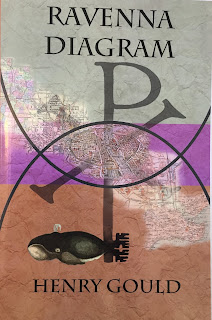I've decided to post whatever I come up with in the way of a reader's guide here on the blog. Most of the poem has appeared on HG Poetics day-by-day, so if possible I will provide a link to the page in question. Otherwise, the actual book is available from Small Press Distribution, or possibly you'll find it in a nearby library.
So here we go. I start with some brief preliminaries, and then some notes for the third poem of RD, titled "Shady Banquet" (which unfortunately is not posted here on the blog; but maybe my notes will encourage some of you to seek it out).
READING NOTES FOR RAVENNA DIAGRAM
PRELIMINARIES
RD is a long poem. It is cumulative, made up of short poems which are added to the whole as they are written, and dated.
The long poem is a sub-genre of American poetry, with its own genealogy. All kinds of poets have written them, since before the American Revolution, from Longfellow to H.D. (Hilda Doolittle) to James Merrill and beyond.
I trace my own lineage in this genre through Whitman, to Pound and his emulators (WC Williams, H.D., Charles Olson, Zukofsky). But my closest affinity is with Hart Crane. In fact I tend to juxtapose what I see as the stance of Crane against that of Pound.
Why? Pound defined the modern epic as a “poem including history”. He traced his own lineage back to Dante, and further back. But I’m absorbed by the question of “history” as well. I base my sense of western and world history on different grounds from those of Pound. So there’s a dialectic going on, an argument with Pound, with assistance from Crane.
I am really not able to summarize what I’m doing with this poem in a few words. It would be a mistake to try : there is so much that remains obscure about it, even to myself. But there seem to be a few constant and recurring themes :
the emotional attraction of Ravenna – as the place Dante finished the Divina Commedia and the place he is buried; as the site of the Byzantine mosaics (which influenced Dante’s own writing); as the location of Antonioni’s mysterious 60s film, Deserto Rosso (Red Desert) starring Monica Vitti & Richard Harris.
an over-arching Orphic dimension, translated to America. My cousin Juliet leapt off the Golden Gate Bridge in 1971, at age 19. This psychic trauma seems to thread into all my long poems. Here it becomes a kind of keynote for a search for spiritual response to suicide and the death-wish in general (including the fate of John Berryman, the poet of the “Henry” Dream Songs, who jumped off a bridge a few blocks from where I live). Juliet becomes a sort of Eurydice/Persephone/Beatrice sign. And this leads to further perusal of the archaic “feminine” underside of history and religion, and involves collisions between our American modernity and archaic native American beliefs & practices.
a re-imagining or re-visiting of theological/philosophical impulses shaping the Divina Commedia. That is, I have my own leanings or conceptions about “transcendental” reality, which I try to address, gradually, incrementally, in this poem. In that sense it’s a sort of spiritual journey, a “new model” Divine Comedy.
RD READING NOTES
“SHADY BANQUET” (p.3)
The sun stands still, as if held in the beak of dogwood limbs. Time halts or pauses.
Northwest Coast Indian mythic image of Raven holding the sun (“the bright sheep-pelt” – golden fleece?) in his beak.
Raven – Cautantowwit – Narragansett main god. God of the afterlife : carried souls to heaven in the “Southwest”.
Series of images from Macbeth. Death’s ghastliness. (A kind of warning to the “Orphic” poet entering these regions.)
“wind sighs through old / pinatas, where a star slips now” : the soul-star is now in the Southwest – land of Mexico, death, pinatas (battered birthday icons). Southwest throughout poem is linked with annual renewal journey of monarch butterflies to Mexico (and sacred “monarchs” in general).
“So listen; hear” – poet or reader is summoned to continue
“Plummet into yon undertow / of marshland tombs” – the realm of Ravenna itself
image in closing stanzas of an elusive anima/soul/spirit – Juliet? Beatrice? “skipping / across her melancholy / diamond”. This introduces a recurring motif drawn from Pound’s lines in Cantos : “For me nothing / But that the child / walk in peace in her basilica”





No comments:
Post a Comment